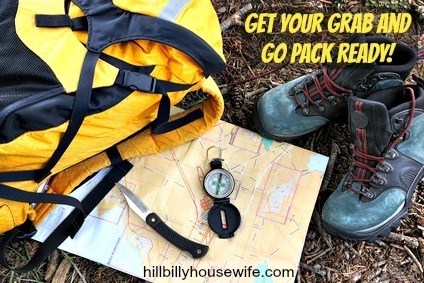Prepare Survival Essentials In A Grab And Go Pack
Having a bag packed and ready to go in case of a sudden evacuation or emergency is good advice. You’ll have peace of mind knowing that you’ve prepared for each member of the household to ‘grab and go’ their own pack if the times comes to make a hasty departure.
Here’s a few things to think about when planning for your own family’s emergency packs:
Who Should Have a Pack?
Every person in your household should have his or her own backpack or other easy to carry bag loaded with essentials, plus any specific items they need. This includes your pets, too.
What Kind of Pack is Best to Use?
A durable backpack is your best choice. Backpacks are made to distribute the weight evenly over the back and shoulders while allowing your hands to be free, making it a good choice for all ages.
In an emergency or disaster, you often have to walk to a safer place so it’s important to plan for comfort. You’ll also find the extra pockets come in handy to separate and store specific items.
What Should You Pack?
Water
Its so important to stay hydrated during an emergency when you will probably be exerting yourself in ways you’re not used to. Dehydration can cause confusion, low blood pressure, fatigue, delirium, unconsciousness, and even death.
FEMA advises each person to have 1 gallon of drinking water per day and to pack enough water for three days. One gallon of water is 128 ounces, which is about 6 to 8 store-bought bottles depending on the size of the bottles. Water is heavy so i f you can’t carry that much water in your pack, plan ahead how you will get enough drinking water from clean sources if you have to leave your home in an emergency.
Food
Pack nonperishable, airtight packaged food. This can be in the form of trail mix, granola, protein or snack bars, nuts and seeds, beef jerky, peanut butter, dried fruit, or individually canned meat (such as sardines, chicken, salmon, and tuna.) Be sure to pack a manual can opener and enough food to last for several days.

Clothes
One of the most important things to have in the event of an emergency or disaster is plenty of clean underwear, socks, a hat, gloves, several thin layers of t-shirts, and a waterproof jacket or windbreaker. In a disaster situation you may have to walk for long distances, so, as soon as your budget allows, pack an extra pair of good walking shoes.
Shelter
This can include many things, but, at the very least, pack a tarp and rope so you can string up a makeshift shelter if needed. A small pop up tent is ideal. Include a small roll of plastic sheeting in each person’s pack to form a waterproof layer on the ground for sleeping and sitting just in case you do need to sleep outdoors.
What Else Should You Pack?
Besides water, food, and shelter, there are essentials that everyone should have access to when an emergency situation occurs.
Here’s a short list of items that should be included:
- Prescription medications and over the counter medications
- First aid kit
- Flashlight, extra batteries, or a hand crank flashlight
- Rain poncho
- Waterproof matches
- Copies of identification and other important papers you may need, in a waterproof container or plastic Ziploc bag. Also, prepare a sheet or card for each person with important information, including address, phone, school or work address, parents’ names, kids’ names, other family names and addresses, health information, etc. Have it laminated to protect against water damage and wear.
Space will be at a premium, so carefully pack all items into each backpack. Clearly mark each pack with the household member’s name and the date it was packed. As time passes, the family’s needs will change, so it’s a good idea to mark your calendar to evaluate your packs often. Some items, such as medication and food, will need to be checked and changed out periodically. Even identification information may change, such as work or schools, phone numbers, etc.
Designate a place in your home to meet in case of evacuation and if possible, store the packs in that location. That way, in the event of an emergency evacuation, your family can easily identify their own pack and will be able to grab it and go.
Remember to practice your evacuation procedures each time you update the packs. This will keep your safety procedure fresh in everyone’s minds. You may never need to put these packs to the test, but it’s better to know that everyone’s ready just in case.
To support the blog, check out the HBHW eBooks available on Amazon. Thank you!
Disclosure: Some of the links below are affilate links, meaning, at no additional cost to you, I will earn a commission if you click through and make a purchase.

